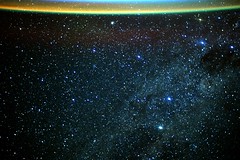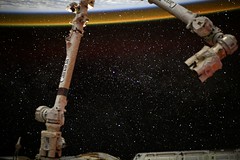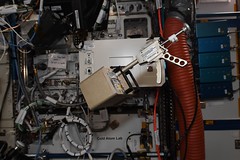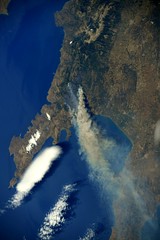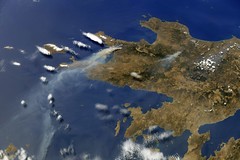Stars
lundi 30 août 2021 à 09:34Thomas Pesquet posted a photo:
:stars: Si vous avez l’occasion de sortir regarder les étoiles ces jours-ci, vous aurez peut-être la chance de voir les Perséides. Cette pluie d’étoiles filantes est très active chaque année autour du 12 août. En théorie on peut les voir aussi depuis la Station spatiale internationale, mais c’est très difficile à photographier - comme sur Terre, parce que c'est trop rapide. La traînée est plus facile à observer quand on désorbite un vaisseau cargo, parce que c'est plus volumineux qu’un bout de roche, et qu'on sait où et quand regarder ! Les étoiles en revanche, sont tout à fait visible depuis la Station. On nous demande parfois pourquoi on ne les voit pas sur les photos, qui montrent un ciel uniformément noir : c'est une question de contraste lumineux. Quand on a la Terre ou un vaisseau spatial (qui reflètent une tonne de lumière) dans le viseur, l'appareil photo s’adapte, comme l’œil, à la luminosité ambiante et les étoiles, comparativement bien moins lumineuse, n'apparaissent pas. Il suffit de quelques réglages pour les capturer sur la pellicule :milky_way::star:
.
:stars: A tip to go outside tonight and try to spot the Perseid meteor showers that will be at their most active. People sometimes ask why you don't see stars in pictures from the Space Station, and the sky is empty and black. A camera works like an eye and adapts to the overall brightness of the scene. As soon as Earth or a spacecraft is in view, and since they reflect a ton of light, you can’t really see stars anymore (or the Earth/spacecraft would be totally overblown). The camera (like the eye) struggles to capture both. Just like moving from a brightly lit area to a darker one on Earth, you can’t make out the details at first, until your eye adapts! And so up here you need to shoot at night, when the overall light level is low, and with the right settings, to make stars appear… and it’s magical. But they’re always there, whether you see them or not! In theory we can see meteorite showers from the International Space Station too, but they are hard to photograph because they go so quickly (just like on Earth of course!) :milky_way::star:
Credits: ESA/NASA–T. Pesquet
607I9288
